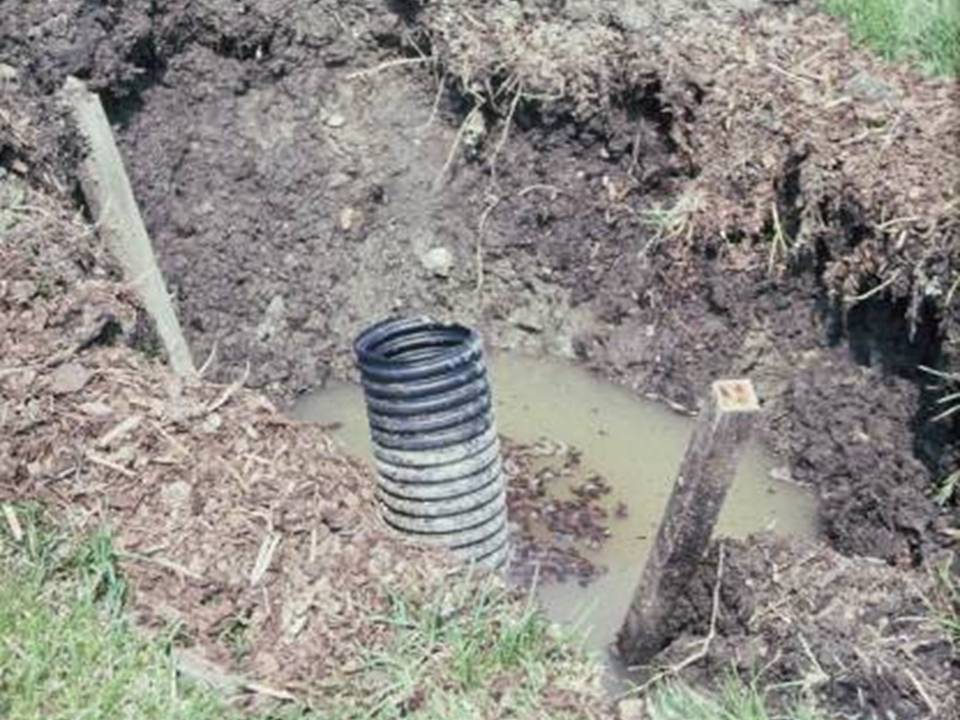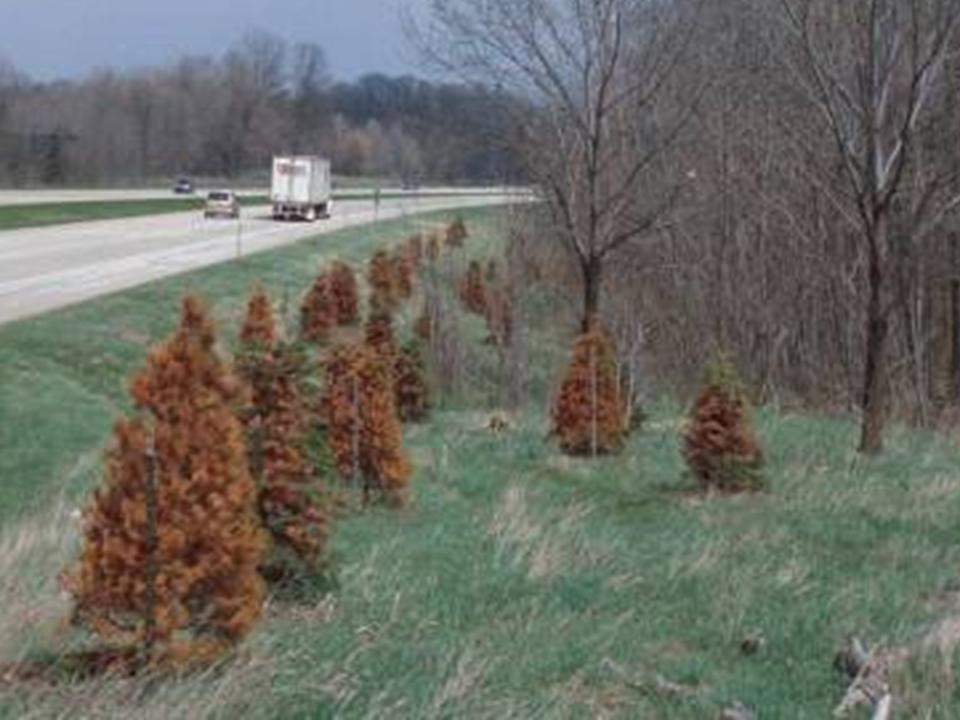Recently I posted that many of the “rules” that gardeners cling to so tightly regarding tree planting (i.e., dig the planting hole 3 times the width of the root ball, always amend the backfill with organic matter) are probably better considered ‘suggestions’ than rules. While these practices won’t hurt, there are much better ways to spend time and effort to ensure long-term survival when planting a tree. Here are the top four:
Irrigate. No matter how much time and effort goes into the ‘perfect’ planting hole; for most parts of the country, trees that are not irrigated after planting are doomed. Linda advocates watering in several small sips during the week; I still stick to the old school notion of one long soak per week. In the final analysis, logistics will probably dictate which approach you use. Either way, the key is to provide trees with water during the establishment year and even into the second year after planting, if possible.
Mulch. Organic matter placed properly on top of the planting hole will do more good than organic matter placed in the planting hole. Study after study demonstrates that mulch conserves soil moisture by reducing evaporation from the soil surface, controls weeds, and moderates soil temperature. Oh, and that business about wood-based mulches ‘tying up’ or ‘stealing’ nutrients from landscape plants? Maybe for bedding plants, but not for trees and shrubs. Our research and other studies indicate that, for the most part, the type of organic mulch makes little difference compared to not mulching at all. Hence, my motto “Mulch: Just do it.”

Proper planting depth. Width of the planting hole may not matter, but planting trees too deep is a recipe for disaster. Burying roots too deep reduces oxygen levels around the roots and starts a series of unfortunate events for the tree. Find the root collar flare and keep it visible.

Bad move. The contractor was going to install drain tile but decided not to at the last minute to save money. Ouch.
Right tree, right place. In my experience, the number one reason newly-planted trees fail in the first year is lack of watering and aftercare. After year one, improper tree selection takes the top spot. Here in the Upper Midwest, poor drainage and heavy soils take their toll year after year. Lack of water can usually be addressed, but once a tree is planted in a spot that is too wet for that species, it’s usually a long, slow, and agonizing decline. And it’s amazing how often people will ignore obvious red flags in selecting trees. Our Dept. of Transportation recently planted 25 eight-foot B&B eastern white pine, which are notoriously salt sensitive, about 30’ from I-96 at a rest area between Lansing and Detroit. Predictably, after one winter’s exposure to deicing salt spray all the trees were dead or wishing they were dead. Right tree, right place. This ain’t rocket science, folks.

Doesn’t more frequent smaller waterings lea
620
d to shallow roots? I’ve never been to Michigan but those dead trees look familiar; I’ve probably seen the same problem elsewhere.
Oh goodie, now you’re discussing my world as a big part of my business is planting bearing age fruit trees in the northeast for home and estate orchards. Sexually mature trees provide the best test for the requirements of successful and rapid establishment of transplanted trees as a high percentage of the trees energy is going to go into next years flowers, even if you can get your customer to remove flowers or fruit on the year they’re planted.
My advice would be, consider the site. I’d never put amendments in the planting hole but sometimes it’s well worth amending the top few inches of soil where the roots need to grow during establishment- especially if the site is in one of these developments where topsoil has been removed and a thin layer returned just to allow a bit of grass to grow. Real compost, not peatmoss but the black, nearly pure humus stuff can be thoroughly mixed with the “topsoil” going out a few feet from the trunk and down 6-9″.
And hasn’t it been well established that roots can grow more easily in relatively loose soil? In most soils I believe it beneficial to to this at least as far as roots are likely to penetrate in first year or two of establishment. I’ve seen research that backs up this approach- is there something new out there contradicting it now? Just break it up about a foot deep- no need to do
19e0
it by digging a larger hole.
I agree with the mulch part 100% and I often establish these trees without the benefit of irrigation beyond the not always reliable rain. My success relies on mulch most of all. Of course irrigation can be more than helpful but in the humid regions of the country it is not always necessary.
Carl Whitcombs experiments with irrigation seem to support Linda. Shallow watering of trees doesn’t create a shallow root system- The fine roots develop where ever the going is best and this changes throughout the season. The major structural roots will not dissappear down lower in the soil just because the trees getting what it needs near the surface during drought or during summer.
Frequent light waterings is the more economical irrigation approach. I bet that’s why Linda recommends it. Seems like solid advice in the arid west.
Oops, upon further reflection I may have not exactly gotten my facts straight on shallow versus deep irrigation. What I said applies to established trees (as I understand it) and it is true that in the east, shallow watering is a good way to manage even transplants because when rain comes in summer it often only penetrates the top couple inches of soil so shallow watering works in concert with that.
However if you have all the water you need to do the deep watering, I’ve no idea if that wouldn’t be helpful for establishment over shallow watering. Is there any specific research on this issue?
I remember reading the proceedings of an arborists conference a few years ago, though I can’t remember which conference it was. There was a guy who presented the findings of a trial he conducted into a large swathe of all the different soil ameliorates which promised to ‘increase tree health/growth’ etc. Water crystals, compost, ‘turbo booster’, seaweed and the like were all trialled over a 5 year post-planting period. The condition in which the trees performed the best were those without any soil amelioration and a thorough mulching. Moral of the story? Supposed water saving and plant invigorating additives promoted in nurseries are all basically tosh.
I think Linda and I have left our debate on frequent,light watering vs. less frequent watering in the ‘agree to disagree’ file. Linda would argue that deeper watering results in water going below the root zone and therefore is wasted water. I’m sticking with the old company line that roots follow resources and deeper watering will result in deeper rooting. Unfortunately, we see lots of cases where trees get neither and are left literally twisting in the wind.
Bert, but the soil most years will naturally be deeply soaked coming out of winter, so in early spring when major root growing occurs, roots will grow deep no matter what.
Orchards all over the world are managed with drip irrigation, sometimes on full sized rootstocks (nut trees, for instance). If those trees developed shallow root systems they’d pitch over in the wind.
I’m amazed this issue hasn’t been resolved by research given the importance of water resources.
There’s a project for a graduate student here.
See books of Carl E. Whitcomb, who laid most of this to rest years ago.
And who found that amending of planting holes was often actually deleterious. This was coming to light by the late 1960’s.
Bert, I just can’t let this go, my mind is fixed on the question of frequent light versus occasional heavy waterings affect on root structure (depth).
You guys are the “Garden Professors” and this is a pretty fundamental and very important question. I’m counting on you and Linda coming to concensus on this based on the available research. Go back to court- resolve this. Please.
Ron, read 2 of Whitcomb’s books, got one on my shelf, Est. and Mt.of LS Plants- actually copyrighted in 1987- most research done in 70’s.
It resolved putting stuff in planting holes- perhaps- but not amending soil in general- especially “problem soil”. I’m still trying to sort out best methods to deal with soil where contractors have dumped blue clay over sand and other brilliant strategies that go on during house construction- even on sites where price was obviously not the primary object.
Does the research take into account what type of soil the trees are planted into? In the North Texas area, we have very tight, compacted, black, clay, alkaline soils. The consensus of the gardening community and some of the local extension agents here is that almost always that particular soil type should be amended with compost or other soil amendments prior to planting. What are your thoughts on this? Thanks.
Regarding deep vs. shallow watering are you talking about new plants or established plants? I think that established plants with good root systems would be OK with shallow watering while new plants would be better with deep watering to establish a good root system. Also, how deep is deep and shallow?
Laura:
As good Garden Professors we can always be swayed by solid, replicated scientific research. If your local extension agents can point us to the studies they’re going on we’d like the see them. Most studies on soil amendments so little or no benefit, see http://www.sustainablehorticulture.com/myth-soil_amendments.pdf for some examples.
Alan:
I’m glad we’ve given you something to keep your mind occupied! For most landscape situations that we deal with in this part of the world, irrigation is mainly an issue during establishment (years 1 and 2). To my knowledge, there have been few scientific studies directly comparing irrigation frequency during establishment of landscape trees. Ed Gilman (1998. J. of Arb. 24:1-9) found that increasing irrigation frequency increased growth of container-grown trees (1 pt to Linda) but had no effect on B&B trees (neener, neener, neener!). I would add a caveat that this study was done in Flor
ida in sand. I suspect that elsewhere on loam or clay soils with more forgiving climates it would be difficult to find a difference.
Bert, I’ve seen a lot of the basic research on soil amendments, and what I’ve seen has been about adding substances like peat moss and pine bark to planting holes creating interruptions in capillary pull.
I’ve never seen a study that actually duplicated natures method of soil amending besides mulching, which incidentally is a kind of soil amending and vastly changes the soil over time.
Where plants are left alone to create there own soils you can see, I believe, what any particular species likes.
Prarie species like a relatively homogenous soil as is created in the prarie while forest species seem to like a soil that is heavily top-dressed annually creating a parfait of varying textured and thin horizons. In spring the roots are most active in the almost pure humus layer below the mulch of leaf litter. It is airy and warms early. As the season progresses, root activity tends to move deeper as the surface dries and the lower levels warm up.
I don’t need to wait for the researchers to know that if I go beyond mulching, and change the soil directly below the mulch to a soil much higher in humus (maybe six inches depth) that goes well beyond the existing root structure of the transplanted tree I will get superior results to mulch alone in excessively heavy soils. Put your hands in a forest soil and you’ll see, I’m only duplicating what’s there.
All this is doing is speeding up the creation of the soil mulch creates over time. It won’t help much with forest trees because you’d have to amend too much soil but for semi-dwarf fruit trees it can save trees that would die otherwise. I have turned things around on certain sites using this approach.
But then, we’re all in love with our anecdotal observations. Steer me to some research that shows my method hasn’t panned out. I’ll find it hard to believe, but it might shut me up.
I’m in the soil all day, and do my reading when it’s dark, if you know what I mean.
Bert, I should have added that I’m talking about enough quality compost to have impact on a 5-6′ raised ring- up to half a cubic yard.
No one has ever said that you can’t improve the quality of a soil with amendments- only that the amounts needed are cost prohibitive and you get more bang for the buck adding organic matter as a top dressing than working it into the soil. For some soils this just isn’t adequate and people aren’t always willing to put the right tree in the right place when it severely limits their options.
Sometimes I don’t think you professors realize that even middle class people often spend $500 dollars for the purchase and installation of a small tree and you should factor that in when giving advice.
I also would like to thank you for answering my water question, although it wasn’t quite to my satisfaction.
I resolved it in my mind by thinking of all the installations I’ve made where drip type soaker hoses were used for irrigation and frequent light waterings were the norm, coinciding with the frequent light lawn waterings.
Roots systems have always done fine as I’ve occasionally been able to observe the results while replacing a tree. Don’t think it’s so good for the lawns though as it probably encourages fungal disease.
If I’m beginning to sound like one of those annoying students that always takes over a discussion in class, just e-mail me and I’ll tone down. Sorry.
I have very sandy soil and I was taught water half as much twice as often. Doesn’t pay to amend my soil when I transplant trees/shrubs as my sandy soil is quite deep. Also less mulch is better, the photos I could take of the the volcano trees in my are is tremendous.
I do recommend to my customers the planting depth as they do not like to here when I point out trees that will have a shortened life span due to original planting depth. For right tree/right place too many people still shop big box stores for trees which usually are never the right ones to plant. How to overcome this I don’t know.
Bert, Linda…I just planted a semi dwarf appl and a semi dwarf weeping peach tree. I live in NC and it gets prette cold up here and the soil is clay. I dug to where when planted the top of the root bal was even with the ground. I’m concerned with over watering and the water not draing on away from the tree roots. They are planted on a pretty well sloped area. I mulched with grass clippings and plan to get some pine needles but someone said mulch could keep oxygen from the roots. Information on these things can be kinda confusing to newbies like me. I did soak them with water and plan to continue watering every day and will put nutrient rich top soils on top of the ground around the tree since I read this post. Thank you all for your information. Will be glad to receive any more you may be able to give me.
Glenda:
Couple of points. Grass clipping are usually a poor choice for mulch since they can mat together and limited water and oxygen penetration to roots. Pine straw is a better choice. I would not add additional soil to the surface. If you planted the tree at the proper depth it should be good where it’s at. Lastly, watering every day shouldn’t be necessary. As long as the tree still has leaves twice a week, or even once a week should be enough. Even in NC your temps are cooling enough the tree shouldn’t be under too much stress. Be sure to resume watering in the spring and summer if you’re not getting a good rain at least once a week.